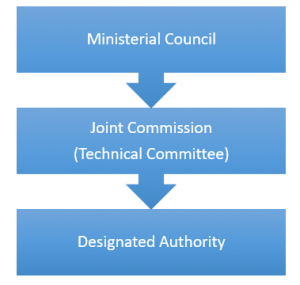The Joint Management Area (JMA) is an Extended Continental Shelf (ECS) area of about 396 000 km², of which Seychelles and Mauritius share joint jurisdiction.
In 2007, considering the overlap in the extended Continental Shelves of Seychelles and Mauritius in the Mascarene Plateau Region, the two Governments resolved to make a joint submission to the UN Commission on the Limits of the Continental Shelf (CLCS). Dedicated teams from the two countries worked arduously, with the support of the Commonwealth Secretariat throughout 2007 and 2008, and on 1st December 2008 lodged the Joint Submission. Technical teams worked together to defend the Joint Submission, and in March 2011, the CLCS made recommendations, confirming the joint jurisdiction of Mauritius and Seychelles over 396,000 km2 of seabed and subsoil of the extended continental shelf beyond their respective EEZ.
Following the recommendations, two treaties were signed by Seychelles and Mauritius in March 2012 concerning the joint jurisdiction of the JMA of the Mascarene Plateau region and concerning the joint management of the ECS of the Mascarene Plateau region.
Under the first Treaty, the two states established the outer limits of the extended continental shelf in order to provide for its recognition under the respective national laws and for the purposes of international law. They also agreed to exercise sovereign rights jointly for the purpose of exploring the continental shelf and exploiting its natural resources. This is reflected in the relevant provisions of the 1982 United Nations Convention on the Law of the Sea (UNCLOS, which provides that a coastal State has exclusive sovereign rights over areas of continental shelf extending beyond the limits of the Exclusive Economic Zone, but in respect only of the exploration and exploitation of the mineral and other non-living resources of the seabed and subsoil (such as oil, gas and other hydrocarbons), together with sedentary marine living organisms.
The second Treaty, which has a lifespan of 30 years established the Joint Management Area (JMA) and provided an institutional and regulatory framework for its management, including the conservation, development and exploitation of its natural resources. The treaty is unique and is the first of its kind as it makes provisions for the joint management of the largest area of maritime space in the world that is subject to joint management.
Both the Governments of Mauritius and Seychelles have fully subscribed to the 2030 Agenda for Sustainable Development and the Paris Agreement on climate change therefore there is a strong focus on the Sustainable Development Goal (SDG) 14 which concerns “life under water”, and comprises of setting up a framework to sustainably manage and protect the marine ecosystems from adverse anthropogenic sources.
Both countries therefore reaffirmed the importance of jointly managing the natural resources of the Joint Management Area in such a manner that is sustainable and consistent with the precautionary principle and the protection of the marine environment and biological diversity of the area.
The JMA is managed using a three-tiered administrative structure.

However, for now, a Designated Authority has not been established. Therefore the focal person for Seychelles is Mr. Chrissant Barbe, the Principal Policy Analyst of the Department of Blue Economy. Whereas for Mauritius, the focal person is Dr. Rezah Badal, Director General, Department of Continental Shelf and Maritime Zones Administration and Exploration, Ministry of Defence and Rodrigues.
As part of the management, framework three major legal instruments have been agreed upon by the two countries for proper and effective management of the jointly managed area:
These legal instruments need to be domesticated in both country’s legislations.
There was a three-year Strategic Plan for the Development of the Joint Management Area from 2018-2020 that focussed on the sustainable management of the resources on the seabed and subsoil of that area. Being the first strategic plan for the management of the area, its aim was to set the scene for the proper, effective and efficient development of the Joint Management Area (JMA) and the establishment of the necessary structures for the sustainable management of the resources in its seabed and subsoil.
Since that Strategic Plan was only for 3 years, a new Strategic Plan is being developed which will cover the next 5 years.

Ministry of Fisheries and Blue Economy
2nd Floor Maison Collet
Palm Street, Victoria, Mahé
P.O Box 408
Republic of Seychelles
+248 4672300
info@mofbe.gov.sc
